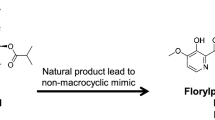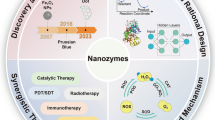Abstract
Poly ADP-ribose polymerase-1 (PARP-1) inhibitors have been recognized as new agents for the treatment of patients with breast cancer type 1 (BRCA1) disorders. The quantitative structure–activity relationships (QSAR) technique was used in order to achieve the required medicines for anticancer activity easier and faster. In this study, the QSAR method was developed to predict the half-maximal inhibitory concentration (IC50) of 51 1H-benzo[d]immidazole-4-carboxamide derivatives by genetic algorithm–multiple linear regression (GA–MLR) and least squares–support vector machine (LS–SVM) methods. Results in the best QSAR model represented the coefficient of leave-one-out cross-validation (Q 2cv ) = 0.971, correlation coefficient (R2) = 0.977, Fisher parameter (F) = 259.016 and root mean square error (RMSE) = 0.095, respectively, which indicated that the LS–SVM model had a good potential to predict the pIC50 (9 − log(IC50 nM)) values compared with other modeling methods. Also, molecular docking evaluated interactions between ligands and enzyme and their free energy of binding were calculated and used as descriptors. Molecular docking and the QSAR study completed each other. The results represented that the final model can be useful to design some new inhibitors. So, the knowledge of the QSAR modeling and molecular docking was used in pIC50 prediction and 51 new compounds were developed as PARP-1 inhibitors that 9 compounds had the best-proposed values for pIC50. The maximum enhancement of the inhibitory activity of compounds was 33.394%.
Graphic abstract












Similar content being viewed by others
References
Sengodan SK, Sreelatha KH, Nadhan R, Srinivas P (2018) Regulation of epithelial to mesenchymal transition by BRCA1 in breast cancer. Crit Rev Oncol/Hematol 123(January):74–82. https://doi.org/10.1016/j.critrevonc.2018.01.008
Sharma B, Kaur RP, Raut S, Munshi A (2018) BRCA1 mutation spectrum, functions, and therapeutic strategies: the story so far. Curr Probl Cancer 42(2):189–207. https://doi.org/10.1016/j.currproblcancer.2018.01.001
Vos S, van Diest PJ, Moelans CB (2018) A systematic review on the frequency of BRCA promoter methylation in breast and ovarian carcinomas of BRCA germline mutation carriers: mutually exclusive, or not? Crit Rev Oncol/Hematol 127(May):29–41. https://doi.org/10.1016/j.critrevonc.2018.05.008
Song D, Huang H, Wang J, Zhao Y, Hu X, He F, Yu L, Wu J (2017) NF90 regulates PARP1 mRNA stability in hepatocellular carcinoma. Biochem Biophys Res Commun 488(1):211–217. https://doi.org/10.1016/j.bbrc.2017.05.037
Zhou J, Ji M, Zhu Z, Cao R, Chen X, Xu B (2017) 1H-benzo[d]immidazole-4-carboxamide derivatives as novel poly (ADP-ribose) polymerase-1 inhibitors with in vivo anti-tumor activity. Eur J Med Chem 132:26–41. https://doi.org/10.1016/j.ejmech.2017.03.013
Park SH, Noh SJ, Kim KM, Bae JS, Kwon KS, Jung SH, Kim JR, Lee H, Chung MJ, Moon WS, Kang MJ (2015) Expression of DNA damage response molecules PARP1, γH2AX, BRCA1, and BRCA2 predicts poor survival of breast carcinoma patients. Transl Oncol 8(4):239–249. https://doi.org/10.1016/j.tranon.2015.04.004
Rabenau K, Hofstatter E (2016) DNA damage repair and the emerging role of poly(ADP-ribose) polymerase inhibition in cancer therapeutics. Clin Ther 38(7):1577–1588. https://doi.org/10.1016/j.clinthera.2016.06.006
Aouidate A, Ghaleb A, Ghamali M, Ousaa A, Sbai A, Bouachrine M, Lakhlifi T (2018) 3D QSAR studies, molecular docking and ADMET evaluation, using thiazolidine derivatives as template to obtain new inhibitors of PIM1 kinase. Comput Biol Chem 74:201–211. https://doi.org/10.1016/j.compbiolchem.2018.03.008
Momeni M, Riahi S (2014) Prediction of amines capacity for carbon dioxide absorption in gas sweetening processes. J Nat Gas Sci Eng 21:442–450. https://doi.org/10.1016/j.jngse.2014.09.002
Mehraein I, Riahi S (2017) The QSPR models to predict the solubility of CO2 in ionic liquids based on least-squares support vector machines and genetic algorithm-multi linear regression. J Mol Liq 225:521–530. https://doi.org/10.1016/j.molliq.2016.10.133
Ghaslani D, Gorji ZE, Gorji AE, Riahi S (2017) Descriptive and predictive models for Henry’s law constant of CO2 in ionic liquids: a QSPR study. Chem Eng Res Des 120:15–25. https://doi.org/10.1016/j.cherd.2016.12.020
Hasanebrahimi G, Riahi S, Fini MF (2017) Exploring beneficial structural features of ionic surfactants for wettability alteration of carbonate rocks using QSPR modeling technique. J Mol Liq 240:196–208. https://doi.org/10.1016/j.molliq.2017.05.009
Rezaei B, Riahi S (2016) Prediction of CO2 loading of amines in carbon capture process using membrane contactors: a molecular modeling. J Nat Gas Sci Eng 33:388–396. https://doi.org/10.1016/j.jngse.2016.05.003
Ruiz IL, Nieto MÁ (2018) A new data representation based on relative measurements and fingerprint patterns for the development of QSAR regression models. Chemom Intell Lab Syst 176(March):53–65. https://doi.org/10.1016/j.chemolab.2018.03.007
Chen M, Yang X, Lai X, Gao Y (2015) 2D and 3D QSAR models for identifying diphenylpyridylethanamine based inhibitors against cholesteryl ester transfer protein. Bioorg Med Chem Lett 25(20):4487–4495. https://doi.org/10.1016/j.bmcl.2015.08.080
Scotti MT, Scotti L, Ishiki HM, Peron LM, de Rezende L, do Amaral AT (2016) Variable-selection approaches to generate QSAR models for a set of antichagasic semicarbazones and analogues. Chemom Intell Lab Syst. https://doi.org/10.1016/j.chemolab.2016.03.023
Hernández N, Kiralj R, Ferreira MM, Talavera I (2009) Critical comparative analysis, validation and interpretation of SVM and PLS regression models in a QSAR study on HIV-1 protease inhibitors. Chemom Intell Lab Syst 98(1):65–77. https://doi.org/10.1016/j.chemolab.2009.04.012
Liu Z, Liu Y, Zeng G, Shao B, Chen M, Li Z, Jiang Y, Liu Y, Zhang Y, Zhong H (2018) Application of molecular docking for the degradation of organic pollutants in the environmental remediation: a review. Chemosphere 203:139–150. https://doi.org/10.1016/j.chemosphere.2018.03.179
He G, Feng L, Chen H (2012) A QSAR study of the acute toxicity of halogenated phenols. Procedia Eng 43:204–209. https://doi.org/10.1016/j.proeng.2012.08.035
Kramer VJ, Giesy JP (1999) Specific binding of hydroxylated polychlorinated biphenyl metabolites and other substances to bovine calf uterine estrogen receptor: structure–binding relationships. Sci Total Environ 233(1–3):141–161. https://doi.org/10.1016/S0048-9697(99)00221-1
Dai Y, Wang Q, Zhang X, Jia S, Zheng H, Feng D, Yu P (2010) Molecular docking and QSAR study on steroidal compounds as aromatase inhibitors. Eur J Med Chem 45(12):5612–5620. https://doi.org/10.1016/j.ejmech.2010.09.011
Ihmaid S, Ahmed HE, Ali AA, Sherif YE, Tarazi HM, Riyadh SM, Zayed MF, Abulkhair HS, Rateb HS (2017) Rational design, synthesis, pharmacophore modeling, and docking studies for identification of novel potent DNA-PK inhibitors. Bioorg Chem 72:234–247. https://doi.org/10.1016/j.bioorg.2017.04.014
Release H (2002) 7.5 for windows, molecular modeling system, Hypercube. Inc. http://www.hyper.com
Frisch MJ, Trucks GW, Schlegel HB, Scuseria GE, Robb MA, Cheeseman JR, Scalmani G, Barone V, Mennucci B, Petersson GA, Nakatsuji H. Gaussian 09 (2009) Gaussian 09, Gaussian, Inc., Wallingford, CT, vol 32, pp 5648–5652
Todeschini R, Consonni V, Mauri A, Pavan M (2002). DRAGON software. Milano, Italy
Kerwin SM (2010) ChemBioOffice ultra 2010 suite. “ProductHomePage @ www.cambridgesoft.com”. PerkinElmer Informatics
Niculescu SP (2003) Artificial neural networks and genetic algorithms in QSAR. J Mol Struct (Thoechem) 622(1–2):71–83. https://doi.org/10.1016/S0166-1280(02)00619-X
Pourbasheer E, Riahi S, Ganjali MR, Norouzi P (2009) Application of genetic algorithm-support vector machine (GA-SVM) for prediction of BK-channels activity. Eur J Med Chem 44(12):5023–5028. https://doi.org/10.1016/j.ejmech.2009.09.006
Basant N, Gupta S, Singh KP (2015) Chemosphere predicting aquatic toxicities of chemical pesticides in multiple test species using nonlinear QSTR modeling approaches. Chemosphere 139:246–255. https://doi.org/10.1016/j.chemosphere.2015.06.063
Roy K, Roy PP (2009) Comparative chemometric modeling of cytochrome 3A4 inhibitory activity of structurally diverse compounds using stepwise MLR, FA-MLR, PLS, GFA, G/PLS and ANN techniques. Eur J Med Chem 44(7):2913–2922. https://doi.org/10.1016/j.ejmech.2008.12.004
Vina A (2010) Improving the speed and accuracy of docking with a new scoring function, efficient optimization, and multithreading Trott, Oleg; Olson, Arthur J. J Comput Chem 31(2):455–461. https://doi.org/10.1002/jcc.21334
DeLano WL (2002) The PyMOL molecular graphics system. http://www.pymol.org
Laskowski RA, Swindells MB (2011) LigPlot+: multiple ligand–protein interaction diagrams for drug discovery. J Chem Inf Model 51:2778–2786. https://doi.org/10.1021/ci200227u
Roy K, Kar S, Ambure P (2015) On a simple approach for determining applicability domain of QSAR models. Chemom Intell Lab Syst 145:22–29. https://doi.org/10.1016/j.chemolab.2015.04.013
Daina A, Zoete V (2016) A boiled-egg to predict gastrointestinal absorption and brain penetration of small molecules. ChemMedChem 11(11):1117–1121. https://doi.org/10.1002/cmdc.201600182
Juretic D, Kusic H, Dionysiou DD, Rasulev B, Bozic AL (2014) Modeling of photooxidative degradation of aromatics in water matrix; combination of mechanistic and structural–relationship approach. Chem Eng J 257:229–241. https://doi.org/10.1016/j.cej.2014.07.053
Jukić M, Rastija V, Opačak-Bernardi T, Stolić I, Krstulović L, Bajić M, Glavaš-Obrovac L (2017) Antitumor activity of 3,4-ethylenedioxythiophene derivatives and quantitative structure–activity relationship analysis. J Mol Struct 1133:66–73. https://doi.org/10.1016/j.molstruc.2016.11.074
de Melo EB, Martins JP, Jorge TC, Friozi MC, Ferreira MM (2010) Multivariate QSAR study on the antimutagenic activity of flavonoids against 3-NFA on Salmonella typhimurium TA98. Eur J Med Chem 45(10):4562–4569. https://doi.org/10.1016/j.ejmech.2010.07.017
Lee A, Mercader AG, Duchowicz PR, Castro EA, Pomilio AB (2012) QSAR study of the DPPH radical scavenging activity of di(hetero)arylamines derivatives of benzo[b]thiophenes, halophenols and caffeic acid analogues. Chemom Intell Lab Syst 116:33–40. https://doi.org/10.1016/j.chemolab.2012.03.016
Fernández M, Caballero J (2007) QSAR modeling of matrix metalloproteinase inhibition by N-hydroxy-a-phenylsulfonylacetamide derivatives. Bioorg Med Chem 15:6298–6310. https://doi.org/10.1016/j.bmc.2007.06.014
Paetz J, Schneider G (2005) A neuro-fuzzy approach to virtual screening in molecular bioinformatics. Fuzzy Sets Syst 152(1):67–82. https://doi.org/10.1016/j.fss.2004.10.015
Gharaghani S, Khayamian T, Ebrahimi M (2013) Molecular dynamics simulation study and molecular docking descriptors in structure-based QSAR on acetylcholinesterase (AChE) inhibitors. SAR QSAR Environ Res 24(9):773–794. https://doi.org/10.1080/1062936X.2013.792877
Cheng Z, Yang B, Chen Q, Gao X, Tan Y, Yuan T, Shen Z (2018) Quantitative–structure–activity-relationship (QSAR) models for the reaction rate and temperature of nitrogenous organic compounds in supercritical water oxidation (SCWO). Chem Eng J. https://doi.org/10.1016/j.cej.2018.07.167
Nantasenamat C, Monnor T, Worachartcheewan A, Mandi P, Isarankura-Na-Ayudhya C, Prachayasittikul V (2014) Predictive QSAR modeling of aldose reductase inhibitors using Monte Carlo feature selection. Eur J Med Chem 76:352–359. https://doi.org/10.1016/j.ejmech.2014.02.043
Acknowledgements
The authors would like to gratefully acknowledge the support from the Institute of Petroleum Engineering (IPE), University of Tehran.
Author information
Authors and Affiliations
Corresponding author
Ethics declarations
Conflict of interest
The authors declare that they have no conflict of interest.
Additional information
Publisher's Note
Springer Nature remains neutral with regard to jurisdictional claims in published maps and institutional affiliations.
Electronic supplementary material
Below is the link to the electronic supplementary material.
Rights and permissions
About this article
Cite this article
Abbasi-Radmoghaddam, Z., Riahi, S., Gharaghani, S. et al. Design of potential anti-tumor PARP-1 inhibitors by QSAR and molecular modeling studies. Mol Divers 25, 263–277 (2021). https://doi.org/10.1007/s11030-020-10063-9
Received:
Accepted:
Published:
Issue Date:
DOI: https://doi.org/10.1007/s11030-020-10063-9




